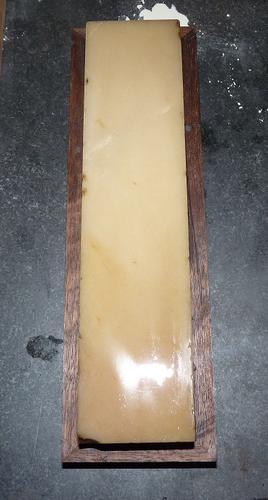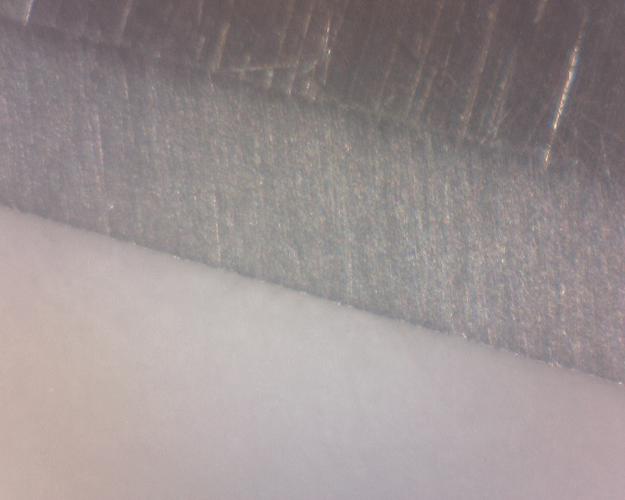Results 1 to 10 of 25
Hybrid View
-
06-11-2014, 02:11 AM #1Senior Member


- Join Date
- Jul 2011
- Posts
- 2,110
Thanked: 459
Yes, visually it's definitely there in the pictures, but not the last one. A brand new jasper has a funny grippy feel from time to time, and I don't know if that's particles that aren't yet broken in (not free particles, but areas of the stone where they're fixed), or if the damage is caused by loose particles, or if it's just caused by the stone itself because it's not ideal.
This last session is still only the third razor this stone has seen since being lapped new. If I had any real fear about it, it would be that when it breaks in it will totally stop cutting, and as euclid440 mentioned, most of this stuff probably isn't very good for beginners. It may be that none of the stones here are, they're slow, and require a little bit of judgement.
Since the jasper is on water (my other owyee slab is on oil, and used for tools, but it could be cleaned off and tried), I may try it with a routing using a good quality tomonagura to speed it up a little and then follow that with a dilution like a japanese stone.
To me, having already spent the money, I definitely like a good japanese stone. It would be wonderful if someone would find these jaspers in large pieces and sell them cheaply in a hone shape, but that's not likely to happen - they'd just end up costing $100 or so for someone to go to the effort to find large bench stone sized pieces and then cut and polish the surface and then chamfer. The big slabs for $10 + shipping make for cheap experimentation.
I know I already mentioned it, but the engraver/jeweler/professional stone cutter who turned me on to biggs jasper swore by the true jaspers for use on engraving tools, each is apparently a little different (though the biggs and owyhee are both fine cutters with sharp particles), and some are not uniformly dense but somewhat porous.
Bottom line with all of these is that they will hold onto their particles and can be worn in and used with good effect with some experience. We talk a lot about the details online, and it drives us a little nutty trying to explain things that are subtle, easy and unspoken with some experience.
Thanks for letting me know who made my razor, btw. I was a little miffed at having spent $60 on it when I got it, but it's turned out to be a really lovely shaver and it likes the natural stones.
-
06-11-2014, 04:03 AM #2

Two things,
1. The simplest way to observe the relative density of areas in a piece jasper is to wet the stone evenly with water. The density of various sections will will be visibly observable by where water is absorbed first. The last areas to absorb water are the densest.
2. The fastest way to break in a hard hone is to burnish it with another hard stone. I do this with barber hones, arkys, ect.
Carry on.
JonathanSHHHH!!!! It's "respect for the age of the blade", NOT laziness! - JimR
- JimR
-
The Following User Says Thank You to Datsots For This Useful Post:
Blistersteel (07-15-2014)
-
06-11-2014, 11:54 AM #3Senior Member


- Join Date
- Jul 2011
- Posts
- 2,110
Thanked: 459
Really great shave this morning again, the best of the bunch so far.
Datsots - brings up a good point. I never rubbed a jasper with a jasper, but they should polish each other. In the case of the owyhee jaspers, no water is absorbed (even water displacer/penetrants like WD 40 are not absorbed). I actually wouldn't mind having a porous piece of jasper for tools, but it's probably the kind of thing I'd need to test in person to make sure I didn't just get a stone that had some holes and a bunch of large smooth quartz inclusions.
-
06-12-2014, 12:14 AM #4Senior Member


- Join Date
- Jul 2011
- Posts
- 2,110
Thanked: 459
A different novaculite - a very old bone colored hard arkansas. This one is hand chiseled on the back (suggesting that it's either very old, or at least sort of old and cut by a company that wasn't pike). It's no finer than the prior stone, but I know it wasn't lapped recently.

And the resulting edge:

Come to the conclusion for yourself. Honing with novaculite is different than the broken in chinese hone or the jasper, as it's not as inherently fine as either. you have to be careful not to apply pressure to hope to get the same finish as the jasper hone does. I'll still give the chinese hone one more go later, as I think it can probably do work without the edge damage that it provided.
Edit: the shave was crispy, of the novaculites I've used so far, the two just aren't as fine as the other three stones in terms of shave smoothness and keenness. Still, a very tolerable shave and the linen would bring the edge right up to where it would need to be.
I'm not sure what I'll do next. I'll periodically add pictures to this thread, and eventually do a razor in crox and one with 0.1 iron oxide (I don't use those things, but I do have paddles with them on - iron oxide causes me to get weepers and crox might look better under the scope, but it is no more keen than the three non-novaculite hones here when you take the time with them and use a linen).Last edited by DaveW; 06-12-2014 at 01:01 PM.
-
07-08-2014, 12:57 AM #5Senior Member

- Join Date
- Mar 2012
- Posts
- 273
Thanked: 43
Dave, A BIG THANKS to you for time spent and your sharing of information on the various hones and the edges they produced.
I live very close to the mine where the Owyhee Jasper comes from and I have a lot of it on hand. I also have a lot of Willow Creek Jasper.
I know Larry that mines the Willow Creek and he will let me go through his stock, hand picking the nicer slabs.
If I get the time I might cut a piece of the blue/green Owhee Jasper that was on the opposite side of the finished edge of your Owyhee slab.
I also have some Owyhee that it slightly porous that has a tan color.
I have worked on a slightly porous piece for an hour or more with 400 grit wetpaper but it still needs much more work before it is ready for honing.
It was a piece that I found that was naturally very flat but in hindsite I would have been better off running it through the diamond blade on the rocksaw that I have, and then working with the 400 grit paper.
Happy honing to ya!!!


 9Likes
9Likes LinkBack URL
LinkBack URL About LinkBacks
About LinkBacks








 Reply With Quote
Reply With Quote